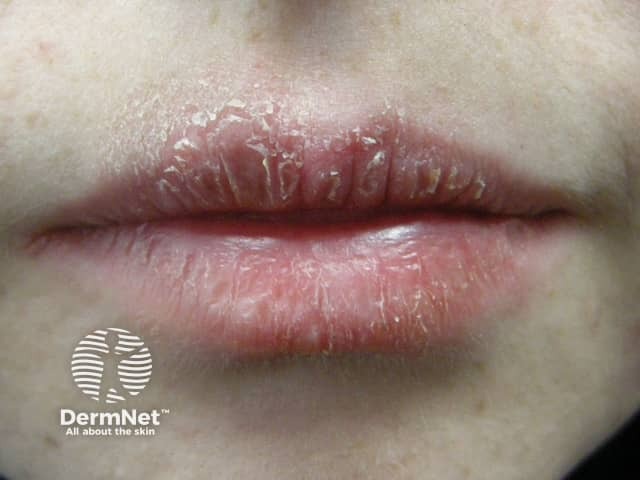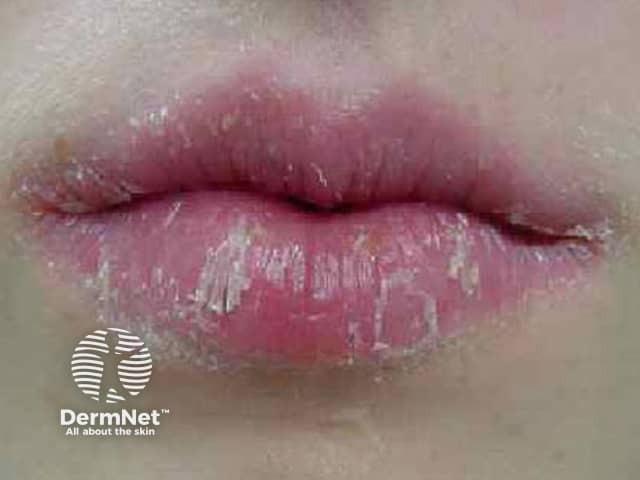Main menu
Common skin conditions

NEWS
Join DermNet PRO
Read more
Quick links
Exfoliative cheilitis — extra information
Introduction - cheilitis Introduction Demographics Clinical features Diagnosis Treatment
What is cheilitis?
Cheilitis means inflamed lips. There are various causes.
What is exfoliative cheilitis?
Exfoliative cheilitis is a rare reactive condition presenting as continuous peeling of the lips.
Factitial cheilitis can present as exfoliative cheilitis when it is due to attention-seeking or factitial behaviour or an obsessive-compulsive tendency to pick or chap the lips (exfoliative).
Who gets exfoliative cheilitis and why?
Exfoliative cheilitis is rarely reported but appears to affect both sexes equally and mainly affects young adults less than 30 years of age.
Some patients diagnosed with exfoliative cheilitis actually have a localised form of psoriasis.
Factitial cheilitis may be triggered by a stressful event leading to an element of self-damaging behaviour.
Whatever the underlying cause, exfoliative cheilitis can be made worse by:
- Mouth breathing
- Lip licking
- Lip sucking
- Lip picking
- Lip biting
- Bacterial (Staphylococcus aureus) or yeast infection (Candida albicans)
Poor oral hygiene has also been reported in association with exfoliative cheilitis and considered to be a possible predisposing trigger. One form of the condition is associated with HIV infection.
Whatever the cause, excessive keratin formation results in abnormal peeling.
What are the clinical features of exfoliative cheilitis?
Exfoliative cheilitis presents with continuous peeling of the vermilion (outer) part of the lips. It may affect just one lip, usually the lower. The lip may look normal or red before the formation of the thickened surface layer. The peeling appears to be cyclical and proceeds at different rates in different sites, so there is always some part of the lip peeling at any time. There may be associated bleeding resulting in the formation of a haemorrhagic crust. When both lips are involved, the lower lip is usually more affected than the upper.

Exfoliative cheilitis

Exfoliative cheilitis
The condition may be painful, causing difficulty in eating and speaking. Other symptoms reported include sensations of:
- Tingling
- Itch
- Dryness
Ulceration or fissuring may occur.
Depression and personality disorders have been reported commonly in association with factitial exfoliative cheilitis. However, the cheilitis itself can be of such an unpleasant appearance that the patient avoids social situations, contributing to mood disturbance.
The typical course of exfoliative cheilitis is chronic over several years. It may fluctuate, worsening with further stress. Spontaneous improvement has been reported, but it often recurs.
How is exfoliative cheilitis diagnosed?
As exfoliative cheilitis can look similar to other conditions, tests are required to exclude these other conditions and secondary infection.
- Swabs should evaluate for candida and Staphylococcus aureus.
- A biopsy should be done but histopathology may be nonspecific.
Exfoliative cheilitis is a diagnosis of exclusion and there is no specific diagnostic test for it. A careful psychiatric assessment can be especially helpful as treatment of an associated mood or anxiety disorder has been reported to also improve factitial exfoliative cheilitis.
What is the treatment of exfoliative cheilitis?
Infection, if present, should be treated topically or systemically.
Unless a predisposing or associated condition can be identified and treated, exfoliative cheilitis is typically resistant to treatment. Unsuccessful use of keratolytic lip balms, sunscreen, antifungal creams, topical steroids, systemic steroids, antibiotics, vitamin D analogues (calcipotriol) and cryotherapy have been described. There has been one report each of the successful use of topical tacrolimus and Calendula officinalis (marigold) ointment 10%.
Treatment of an associated mood or anxiety disorder has been reported to improve factitial cheilitis. Obsessive-compulsive disorders respond best to selective-serotonin-reuptake inhibitors.
References
- Aydin E, Gokoglu O, Ozcurumez G, Aydin H. Factitious cheilitis: a case report. Journal of Medical Case Reports 2008; 2: 29. http://www.jmedicalcasereports.com/content/2/1/29
- Mani SA, Shareef BT. Exfoliative cheilitis: Report of a case. JCDA 2007; 73: 629-632. www.cda-adc.ca/jcda/vol-73/issue-7/629.html
- Roveroni-Favaretto LHD, Lodi KB, anAlmeida JD. Topical Calendula officinalis L. successfully treated exfoliative cheilitis: a case report. Cases J. 2009; 2: 9077.
On DermNet
